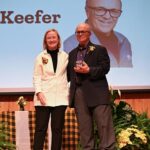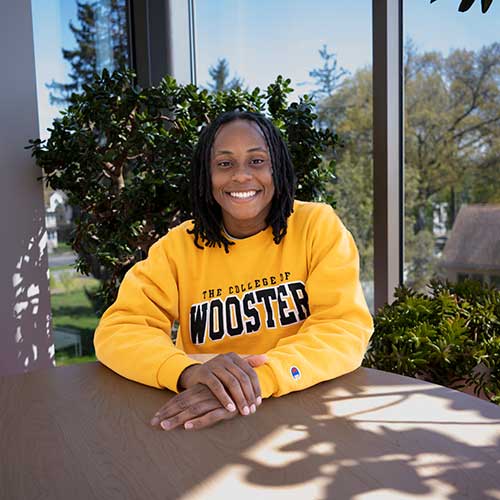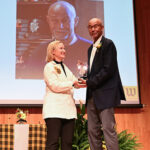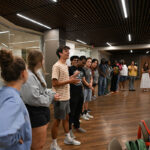
Neuroscience student digs into the impacts of food desert inhabitance on brain development and behavior

As a high school student with a couple psychology courses under her belt, Tyara Thompson ’24 had “fallen in love with the brain.” The Posse Scholar from Lithia Springs, Georgia, matched with The College of Wooster and found her calling on campus. As a first-year neuroscience major in the cognitive behavioral neuroscience track, she became fascinated with the concept of neuroplasticity, the brain’s ability to structurally and functionally change based on a person’s environment and/or experiences.
Then she unexpectedly lost her great aunt to a stroke.
While grieving the loss of a family member, she quickly realized she gained a meaningful research topic. She wanted answers for what caused her aunt’s stroke—and she was going to find them. Thompson recalled her aunt’s health problems related to smoking and COPD, but after looking back on childhood travels to see her aunt in Baton Rouge, Louisiana, something else stuck out: the food environment.
“I seldom remember having a cooked, balanced meal with fruits and vegetables,” recalled Thompson. “I can picture all the fast-food restaurants there because that’s what we ate, but I couldn’t recall a grocery store. I wondered how that ‘food desert’ environment could have affected my aunt’s propensity to stroke,” she added, considering a term she would define in her research.
Thompson worked to align internships and other opportunities that might help her find answers to this mystery on her heart. Thanks to a connection through a course assignment with Anna Damato ’16, a then neuroscience Ph.D. student at Washington University in St. Louis, Missouri, she discovered BP-ENDURE—a Blueprint Program for Enhancing Neuroscience Diversity through Undergraduate Research Education. For two summers, Thompson spent 10 weeks completing cutting-edge research under Alexxai Kravitz, associate professor of neuroscience at Washington University. With permission, Thompson was able to use her findings for her senior Independent Study at Wooster.
Her goal was to draw a connection between the public health side of food desert interventions and the neuroscience side of consumption and motivation. She explained what food deserts are, who they predominantly affect, what foods exist, and what kinds of interventions have been put in place. “Food deserts are correlated with poverty. People can’t afford fresh foods, or they don’t have transportation to the stores that carry these foods,” said Thompson. “Yet, even with various interventions that remove the affordability and accessibility barriers, people still aren’t engaging. They notice the change in their landscape but are stuck in their habits. I wondered if living in this junk-food-laden environment changes the brain, and specifically how it changes reward, decision-making, and habit-forming functionality.”
The second half of her I.S. addresses finding a way to use neuroscience to develop effective solutions that change residents’ behaviors. Using optogenetics methods in the Kravitz Lab, Thompson performed brain surgery on mice to test their ventral pallidum (VP)—a brain area associated with reward and motivated behavior—during junk food consumption. In short, she asked: does inhibiting a key brain area reduce junk food consumption? She injected a virus into the VP that allowed her to inhibit specific cells by shining a light. “When you shine the light that activates those VP cells, it induces immediate feeding,” explained Thompson. “I wanted to find out if we could lower feeding activity by shining a different kind of light that turns those cells off. Some of the mice ate less, but it wasn’t significant.” Thompson highlighted that her study fits into the first step of using neuroscience as a tool in food- desert-solution development: identifying which brain areas matter most when considering food desert inhabitance.
Thompson’s I.S. mentor, Grit Herzmann, associate professor of psychology and chair of neuroscience, said, “Projects like this are challenging (and rewarding) because they involve negotiating with the interests of other laboratories and research lines. They allow our students to experience new lab environments, new lab skills, and help them practice communication between multiple advisors, which is the norm in the neuroscience research field.”
While at Wooster, Thompson also enhanced her communication and listening skills as starting setter on the volleyball team and as a resident assistant. “Being an RA taught me how to communicate with a wide range of personalities, to advocate for myself, to lead by example, and how to meet people where they are at.”
The work she’s done at Wooster and in the lab at Washington lays a foundation for how Thompson wants to approach her doctoral research and career. “My I.S. opens the door for neuroscience to step into the arena and help with food desert solutions. Once we identify which brain areas are affected by high-fat foods and susceptible to change, then we can use this information to guide solution development.”
Herzmann applauded Thompson’s inquisitive nature and perseverance, noting that I.S. is only one stepping stone in this journey. “I think that Ty’s greatest achievement is to be able to see a research trajectory in front of her and not assume that I.S. will provide all the answers already.”
This feature originally appeared in the Summer 2024 issue of Wooster magazine.
Posted in Independent Study, Magazine on June 2, 2024.
Related Posts
Related Areas of Study
Public Health
Explore the many options and paths for those who want to be part of the world of health care
PathwayNeuroscience
Psychology, chemistry, philosophy, computer science, and other disciplines combine in the study of the nervous system
Major

